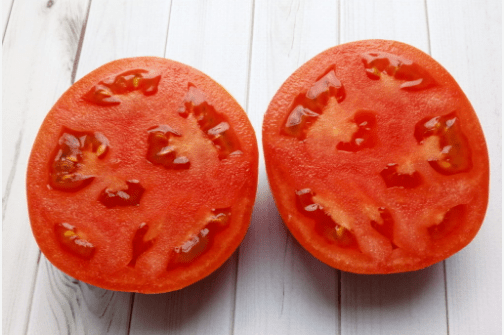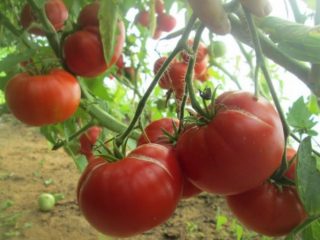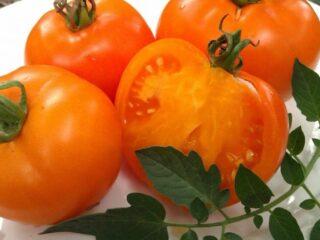Content
Tomato Perseus is a variety that almost every domestic gardener knows about. The variety is very popular due to its increased resistance to plant diseases, ease of cultivation, good yield and versatility of use.
Origin story

The Perseus tomato was bred by Moldovan breeders more than 100 years ago
But in Russia this variety of tomatoes was allowed for widespread planting only in 1992. The vegetable crop is not included in the State Register of the Russian Federation.
Description of the tomato variety Perseus
Tomato Perseus belongs to vegetable crops of determinant growth, suitable for cultivation both in greenhouse conditions and in open ground. The bushes grow up to half a meter in height and are distinguished by lush, dense vegetation. The green leaves of the crop reliably protect the fruits from direct sunlight.
Pollination of Perseus tomatoes grown on open-air plantations is carried out naturally - by winds and insects. In greenhouses, plants are pollinated artificially.
Fully ripened tomatoes have a rich, uniform red color. The average fruit weight is about 100 g, but some specimens reach 180 g. They have a round, slightly flattened shape, medium size and slight ribbing.
Perseus tomatoes are characterized by their universal purpose. They persist for a relatively long time after being removed from the bush, i.e. They have good shelf life and are resistant to transportation. The fruits have dense juicy pulp with a low volume of dry matter, 5-7 seed chambers. This variety of tomatoes is grown by both private gardeners and commercial agricultural firms for sale.
Characteristics of Perseus tomatoes

The Perseus tomato belongs to the category of traditional red tomatoes, which are familiar to every amateur gardener and experienced farmer
The vegetable crop is adapted to development in any climatic regions of Russia and is resistant to heat and temperature drops. The first inflorescence on the plant is formed after the sixth leaf, then more often. Each of them produces 4-6 tomatoes.
Ripening and fruiting
The Moldovan variety Perseus belongs to the mid-early tomatoes. The fruits begin to ripen 105-123 days after the sprouts appear. This period depends on the growing region and conditions (greenhouse, open land).
Perseus tomato yield
Tomato Perseus is characterized by high yield. This is one of the main advantages of vegetable crops. By following standard rules of agricultural technology, you can harvest 6-8 kg/m2 in your own garden bed.And if you provide tomatoes of this variety with more careful care (sufficient watering, additional fertilizing of the soil, timely prevention of diseases and pests, as well as the formation and staking of bushes), then from each square meter of the bed you can get up to 9 kg of tasty tomatoes.
Resistance to adverse factors
The Perseus tomato is characterized by increased resistance to the following plant diseases: Alternaria blight, tobacco mosaic. And the crop is less resistant to damage by macrosporiosis, fusarium and brown spot.
In what regions is it grown?
Perseus tomatoes can be grown in all climatic zones of Russia. In warmer regions, seedlings are planted both in greenhouses and in open beds. In cold regions, this tomato variety is grown in greenhouse conditions.
Methods of application

Perseus tomatoes are universal in use
The fruits can be eaten fresh, in vegetable salads, preserved whole in jars, pressed into juice, made into tomato paste and ketchup, and dried.
Advantages and disadvantages
Ripe tomatoes last a long time and are resistant to transportation. The variety is popular both among private farmers and commercial agricultural firms.

Tomato Perseus, with proper care, gives a fairly good harvest
Pros:
- low growing bushes;
- increased resistance to the harsh climatic conditions of Russia;
- medium-sized tomatoes have excellent taste and are suitable for winter preservation as whole fruits;
- high productivity;
- resistance to certain diseases;
- commercial appearance;
- resistance to transportation, long-term storage;
- the possibility of growing in greenhouses, greenhouses and open land plantations;
- resistance to temperature changes, intense rain and drought;
- versatility of application;
- bushes do not require gartering or pinching.
Minuses:
- tendency to thicken.
Subtleties of landing
Seed material of Perseus tomatoes is planted in a seedling container with fertilized soil in mid-March. Ready seedlings are transplanted to a permanent place of growth in mid-May (greenhouses, greenhouses) or early June (open ground).

In order for the sprouts to sprout faster, the seed material is first germinated in wet cotton wool or gauze.
When using seeds collected independently last season, they must be treated with potassium permanganate, dipping them completely into the solution for 10-15 minutes.
After 2-3 weeks, young sprouts with leaves are planted in separate containers, for example, small flower pots or plastic cups.

Before planting in open ground, Perseus tomato seedlings are hardened
To do this, the plants are taken out into fresh air within two weeks. The first day by 15 minutes, daily increase the hardening time by 10 minutes.
Planting of seedlings is carried out only after warm weather has established (without night frosts).

To transplant seedlings, it is recommended to choose a cool but windless day.
When planting a tomato crop in a permanent place, the seedlings are deepened into fertilized soil by 10 cm. The recommended scheme is 70x50 cm.
The first watering of the vegetable crop is carried out after a week. Next, the soil is irrigated twice a week until the first fruit ovaries form. After this, watering is performed once a week.Watering should be done moderately, as excessive or insufficient moisture often leads to cracking of tomatoes.
Care instructions
To get a good harvest of Perseus tomatoes, the plant needs proper care throughout the growing season.
Basic recommendations for caring for tomato crops:
- Abundant but infrequent watering - up to 3 liters of warm settling water per adult tomato bush.
- Removal of weeds, which take moisture from the soil and microcomponents and nutrients useful for vegetable crops.
- Formation and garter of bushes.
- Periodic loosening of the soil, incl. after each watering, so that the root system of the plant receives a sufficient amount of oxygen.
- Fertilizing the soil with useful components for the rapid growth and development of tomato crops. Nitrogen-containing - at the growth stage, magnesium and boron during flowering, potassium (phosphorus) closer to fruiting.
- Timely prevention of diseases - treatment with special chemical compounds, incl. fungicides.

Excessive fertilizing is much worse for a vegetable crop than its lack.
Diseases and pests

The breeding tomato variety Perseus is characterized by genetic resistance to most plant diseases
Despite this, the plant requires preventive measures.
Basic recommendations for prevention:
- spraying tomato seedlings with a solution of potassium permanganate a week after planting the seedlings in a permanent place;
- Before flowering, the plant is treated with Bordeaux mixture or copper sulfate solution 1 week before flowering.
Recommendations for preventing damage to tomato bushes by whiteflies, aphids, spider mites and leaf rollers:
- planting garlic, mint, tansy, onions and other strong-smelling vegetation next to tomato plantations;
- Wood ash is scattered between the rows of tomatoes;
- timely removal of tomato bushes affected by insects;
- regulation of thickening;
- weed removal.
Conclusion
The Perseus tomato is a common tomato variety in Russia, bred back in the last century by Moldovan breeders. Suitable for growing in greenhouse conditions and on open plantations. The crop is characterized by good resistance to negative weather conditions, therefore it is suitable for cultivation in almost all regions of the Russian Federation. Tomatoes of this variety bear fruit well, are medium in size, have excellent taste, and are universal in use. Perseus is very popular among both private gardeners and commercial agricultural enterprises.
Reviews from gardeners about the Perseus tomato









